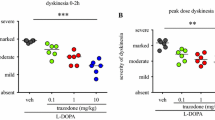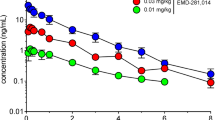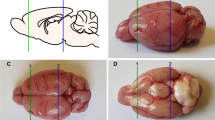Summary
Three monkeys received a chronic intravenous course of 1-methyl-4-phenyl-1,2,3,6-tetrahydropyridine (MPTP) so as to produce a permanent parkinsonian syndrome. One primate was electively commenced on chronic levodopa therapy 6 weeks after the cessation of MPTP treatment. Four months following the termination of MPTP administration, the response to oral doses of the novel D-2 dopamine agonist (+)-4-propyl-9-hydroxynaphthoxazine (PHNO) was assessed in all animals using a clinical rating scale and automatic activity counters.
PHNO was found to be a highly potent anti-parkinsonian agent, completely reversing the symptoms of parkinsonism in a dose-dependent manner. Peak-dose dyskinesia was noted in 2 MPTP-treated animals during trials with PHNO, but was more severe in the animal receiving chronic levodopa therapy. Response fluctuations such as ‘end-of-dose’ deterioration and the ‘on-off’ henomenon were common to all 3 parkinsonian animals following PHNO. The anti-parkinsonian effect and frequency of treatment-induced side-effects appeared to be similar with PHNO and levodopa. These results confirm the efficacy of PHNO as an anti-parkinsonian drug and link the production of dyskinesia with the D-2 dopamine receptor.
Similar content being viewed by others
References
Boyce S, Crossman AR, Mitchell IJ (1987) Autoradiographic demonstration of increased [3H]-spiperone binding in the MPTP-treated monkey. Br J Pharmacol 90:250
Burns RS, Chiueh CC, Markey SP, Ebert MH, Jacobowitz DM, Kopin IJ (1983) A primate model of Parkinsonism: Selective destruction of the substantia nigra pars compacta dopaminergic neurons by N-methyl-4-phenyl-1,2,3,6-tetrahydropyridine. Proc Natl Acad Sci (USA) 80:4546–4550
Clarke CE, Sambrook MA, Mitchell IJ, Crossman AR (1987a) Levodopa-induced dyskinesia and response fluctuations in primates rendered parkinsonian with 1-methyl-4-phenyl-1,2,3,6-tetrahydropyridine (MPTP). J Neurol Sci 78:273–280
Clarke CE, Boyce S, Sambrook MA, Crossman AR (1987b) Timing of levodopa therapy: Evidence from MPTP-treated primates. Lancet i:625
Forno LS, Langston JW, DeLanney LE, Irwin I, Ricaurte GA (1986) Locus coeruleus lesions and eosinophilic inclusions in MPTP-treated monkeys. Ann Neurol 20:449–455
Grandas F, Quinn N, Critchley P, Rohan A, Marsden CD, Stahl SM (1987) Antiparkinsonian activity of a single oral dose of PHNO. Movement Disorders 2:47–51
Guttman M, Seeman P (1985) l-dopa reverses the elevated density of D-2 dopamine receptors in Parkinson's diseased striatum. J Neural Trans 64:93–103
Hinzen D, Hornykiewicz O, Kobinger W, Pichler L, Pifl C, Schingnitz G (1986) The dopamine autoreceptor agonist BHT 920 stimulates denervated postsynaptic brain dopamine receptors in rodent and primate models of Parkinson's disease. Eur J Pharmacol 131:75–86
Hoehn MM, Yahr MD (1967) Parkinsonism: onset, progression and mortality. Neurology 17:427–442
Jenner P, Marsden CD, Nomoto M, Stahl S (1986) Anti-parkinsonian activity of (+)-PHNO in the MPTP-treated marmoset following subcutaneous infusion or skin application. Brit J Pharmacol 89:626
Jones JH, Anderson PS, Baldwin JJ, Clineschmidt BV, McLure DE, Lundell GF, Randall WC, Martin GE, Williams W, Hirshfield JM, Smith G, Lumma PK (1984) Synthesis of 4-substituted-2H-naphth[1,2-b]1,4-oxazines, a new class of dopamine agonists. J Med Chem 27:1607–1613
Langston JW, Ballard P, Tetrud JW, Irwin IJ (1983) Chronic parkinsonism in humans due to a product of meperidine-analog synthesis. Science 219:979–980
Lee T, Seeman P, Rajput A, Farley IJ, Hornykiewicz O (1978) Receptor basis for dopaminergic supersensitivity in Parkinson's disease. Nature 273:59–61
Martin GB, Williams M, Pettibone DJ, Yarbrough GG, Clineschmidt BV, Jones JH (1984) Pharmacological profile of a novel potent direct-acting dopamine agonist, (+)-4-propyl-9-hydroxynaphthoxazine ((+)-PHNO). J Pharmacol Exp Ther 230:569–576
Mitchell IJ, Cross AJ, Sambrook MA, Crossman AR (1985) Sites of the neurotoxic action of 1-methyl-4-phenyl-1,2,3,6-tetrahydropyridine in the macaque monkey include the ventral tegmental area and the locus coeruleus. Neurosci Lett 61:195–200
Nomoto M, Stahl S, Jenner P, Marsden CD (1987) Anti-parkinsonian activity of (+)-PHNO in the MPTP-treated common marmoset. Movement Disorders 2:37–45
Pettibone DJ, Totaro JA, Clineschmidt BV (1987) Binding of (+)-PHNO and other D-2 dopamine agonists to D-1 dopamine receptors labelled by [3H]-SCH 23390. J Neural Transm 69:147–151
Snyder SH, D'Amato RJ (1986) MPTP: A neurotoxin relevant to the pathophysiology of Parkinson's disease. Neurology 36:250–258
Stahl SM, Wets KM (1988) Recent advances in drug delivery technology for neurology. Clin Neuropharmacol 11:1–17
Stoessel AJ, Mak E, Calne DB (1985) (+)-4-Propyl-9-hydroxynaphthoxazine (PHNO), a new dopaminomimetic, in treatment of parkinsonism. Lancet ii:1330–1331
Author information
Authors and Affiliations
Additional information
Send offprint requests to A. R. Crossman at the above address
Rights and permissions
About this article
Cite this article
Clarke, C.E., Boyce, S., Sambrook, M.A. et al. Behavioural effects of (+)-4-propyl-9-hydroxynaphthoxazine in primates rendered parkinsonian with 1-methyl-4-phenyl-1,2,3,6-tetrahydropyridine. Naunyn-Schmiedeberg's Arch Pharmacol 338, 35–38 (1988). https://doi.org/10.1007/BF00168809
Received:
Accepted:
Issue Date:
DOI: https://doi.org/10.1007/BF00168809




